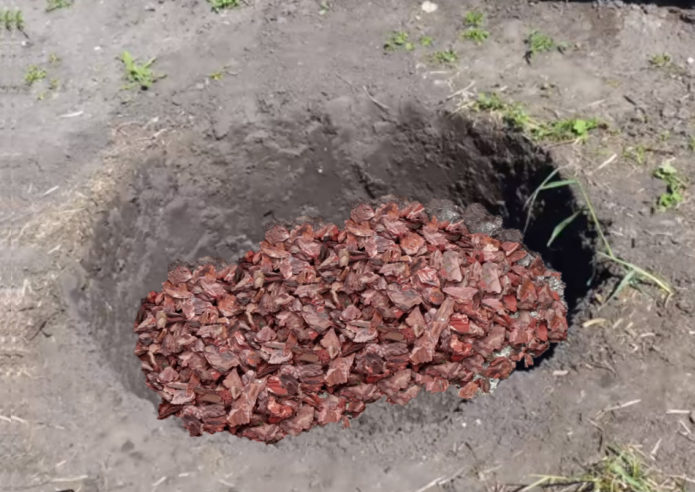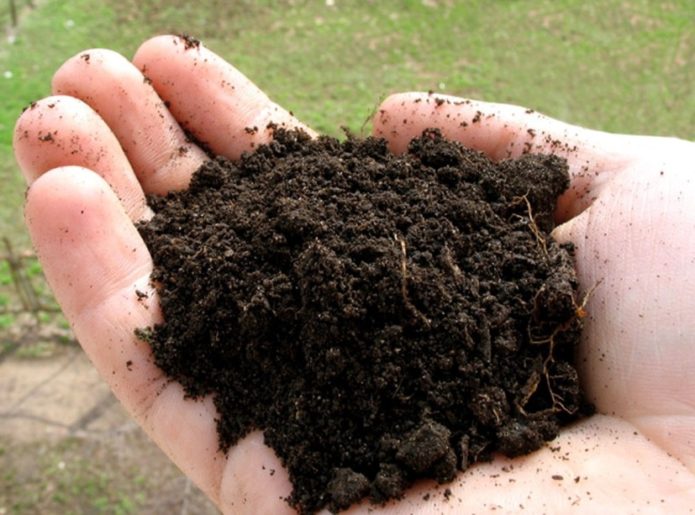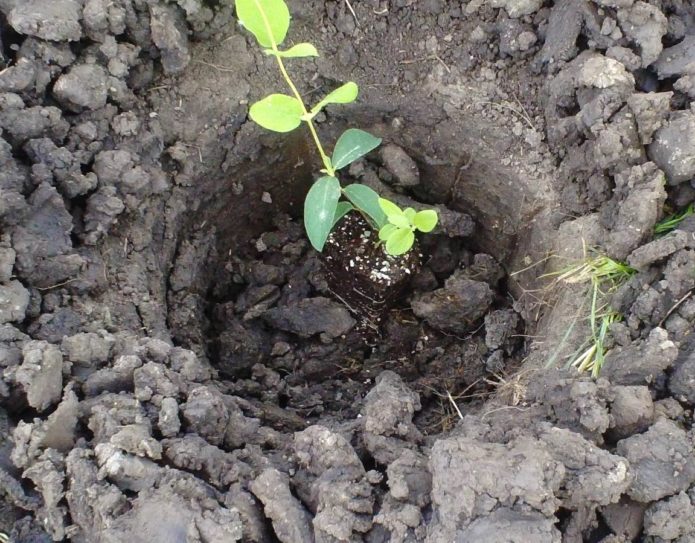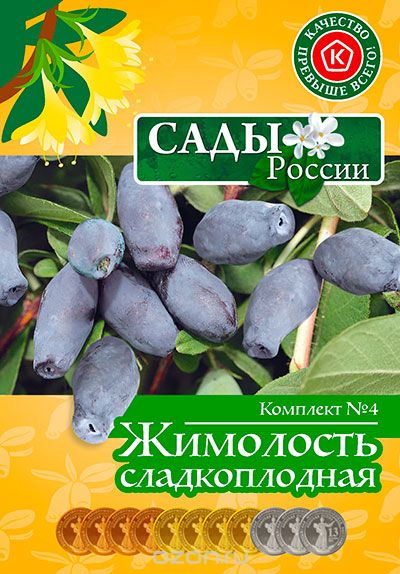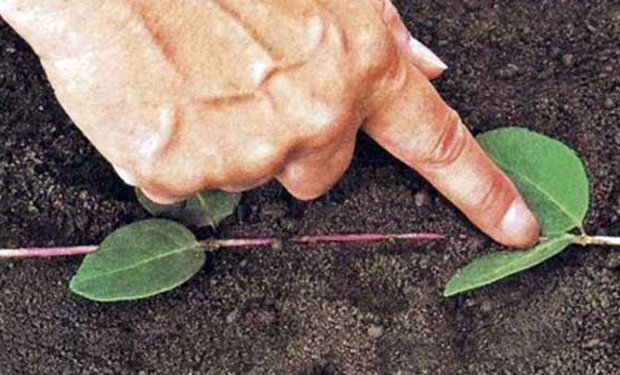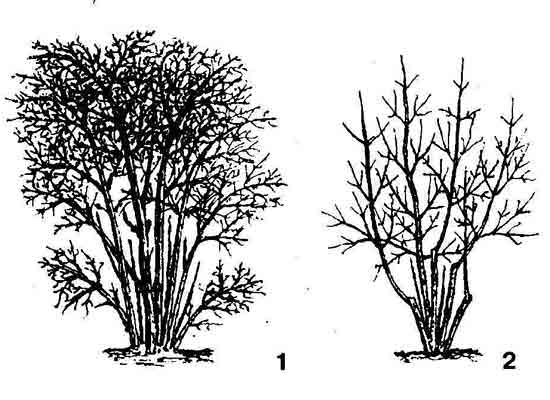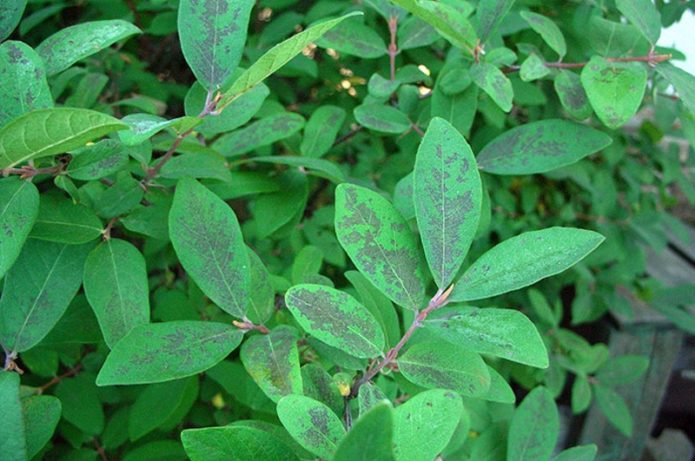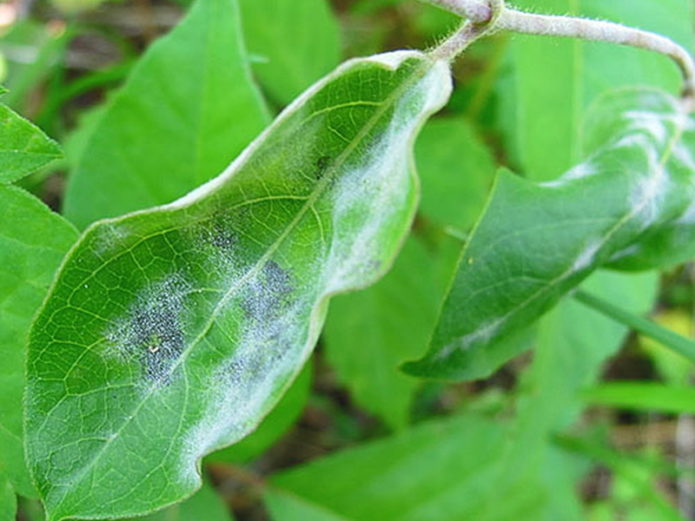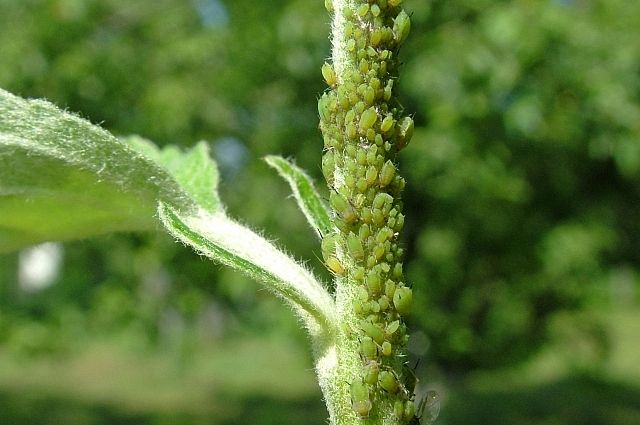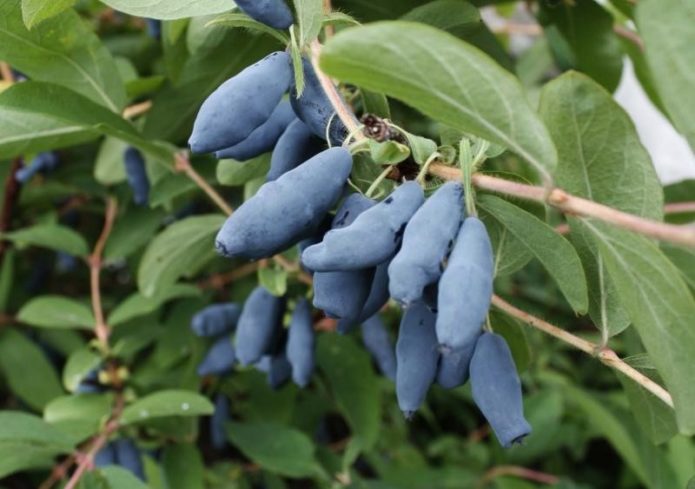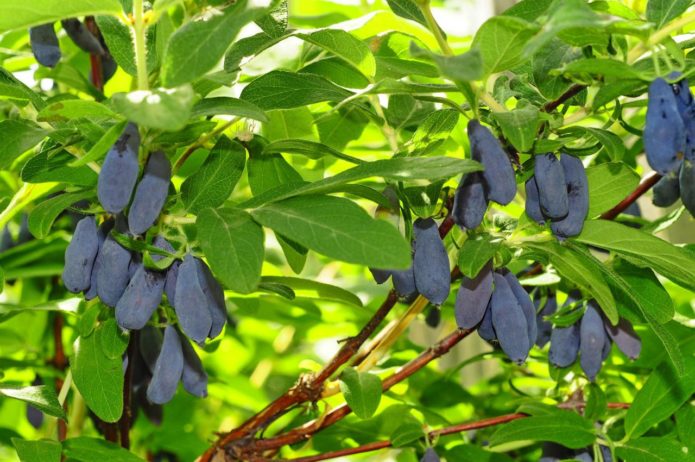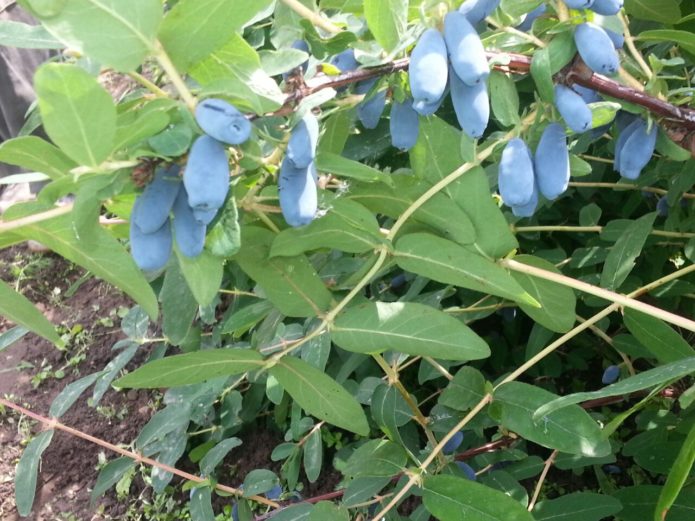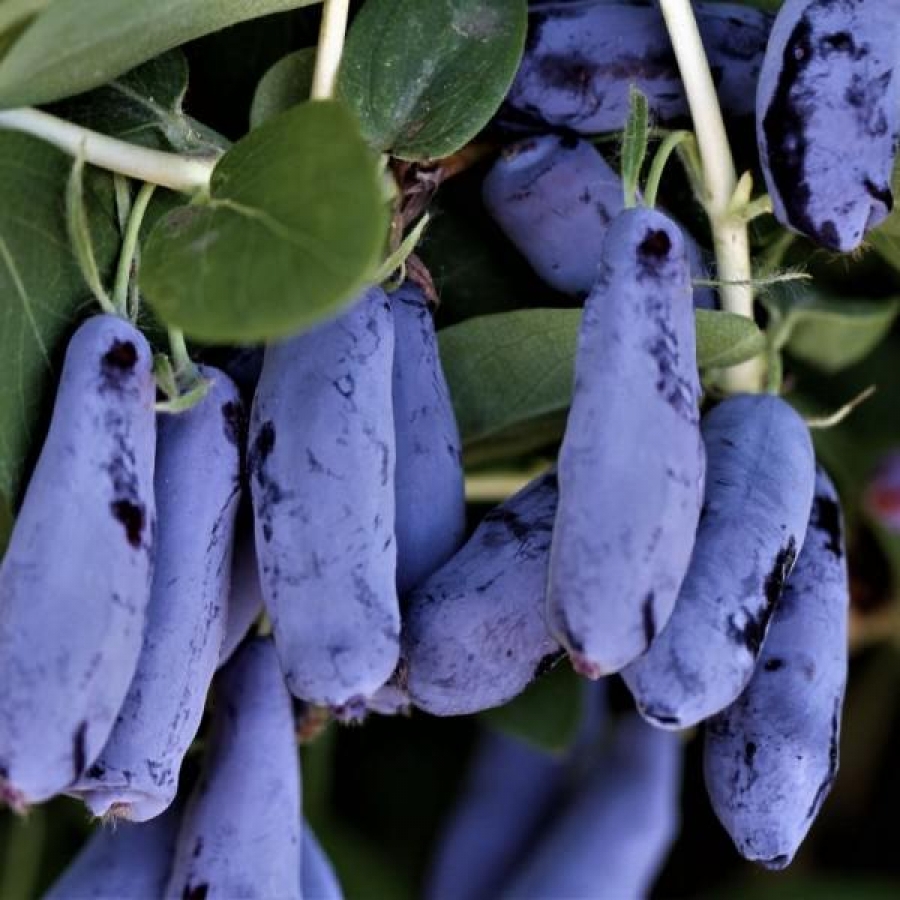Honeysuckle is not the most traditional inhabitant of Russian dachas. Some gardeners do not know her at all. But this is a representative of the earliest fruiting shrubs: its vitamin berries are among the first to ripen. In care, honeysuckle is unpretentious, however, for good fruiting, you need to plant several bushes at once, and then you can feast on healthy berries at the beginning of summer.
Content
What is this berry and how to plant it
Honeysuckle can grow almost anywhere, but in order for it to bring good yields, it is required to plant a shrub in the sunniest areas. In addition to shading, she decisively does not tolerate drafts, simply because she has very fragile, easily breaking branches. Therefore, the best place for planting honeysuckle is almost like for grapes: at a blank fence that covers the bushes on the north side, if there is a tall bush like a lilac or a fruit tree on both sides. From the point of view of relief, hidden from the wind, but not swampy lowlands, are suitable.
Soil for edible honeysuckle
Honeysuckle can grow anywhere, but for a normal existence and high-quality fruiting, it needs to create comfortable conditions. The soils should be of average composition (sandy loam, loam), rich in humus and with a slightly acidic reaction of the medium (pH from 6.0 to 6.5). However, if the soil is neutral, you should not specifically acidify it, but if horsetail is present in abundance on the site, you need to dig up the ground with slaked lime or chalk. Explicit clay is not good, it is also bad if groundwater passes near. In the latter case, a good drainage layer can be poured into the planting hole or some kind of hill can be created.
The planting pit is prepared in the usual way, it should be 40 x 40 x 40 cm in size, not very much fertilizer is placed in it: up to one and a half buckets of compost or humus, a handful of wood ash and 100–150 g of superphosphate. This mixture is mixed well and the pit is allowed to settle for at least a week.
Planting methods for honeysuckle
If there is a ready-made seedling, you can plant it almost at any time, except in May or June, when there is a rapid growth of shoots. But this is only if the seedling has a clod of earth, that is, with a closed root system. An ordinary bush is planted in spring or autumn, best of all in September. Spring planting of honeysuckle without an earthy coma should be carried out only before bud break.
Planting honeysuckle seedlings
For normal fruiting, at least two bushes must be planted: honeysuckle is cross-pollinated.It is desirable that the bushes be of different varieties, but of the same flowering period, best of all - at least 3 copies. A single bush will also give berries, but there will be few of them, it is economically unprofitable to take a place with a single honeysuckle bush.
The distance between the bushes is more than one and a half meters: honeysuckle has fragile branches, and when harvesting, gardeners often, unwittingly, break quite a few of them. Therefore, the bushes should grow freely, and if honeysuckle is planted in two rows, a free passage should be created between the rows. Thus, the optimal planting scheme for honeysuckle is from 2.5 x 1.5 to 3 x 2 meters. The bushes will grow constantly, and they live for at least 20 years, so over time, even with such a planting, thickets are obtained.
Autumn planting is not difficult, but in the spring it is better to try to buy a seedling in a container. The planting date is the earliest, as soon as the soil allows working with it. This means that for spring planting, it is advisable to dig a hole in the fall. For autumn - when free time permits. Honeysuckle is planted almost like any other fruit shrub:
- When preparing the pit, drainage is placed on its bottom - crushed stone, broken brick, just coarse river sand - with a layer of at least 10 cm.
- The upper fertile layer, taken out of the pit, is mixed with fertilizers and returned to the pit, after which it is watered well and the pit is allowed to stand.
- At least a week later, a seedling is brought to the site and, if it has an open root system, it is soaked in water for several hours.
- During this time, a hole is dug in the center of the hole so that the roots of the seedling fit freely in it. It is installed in the hole, making sure that the root collar is approximately at the level of the soil: after the end of planting, it should drop by about 5 cm.
- Spreading the roots, gradually cover them with the removed soil mixture and water the seedling with a bucket of water.
- After absorbing water, a small side is made at the edges of the planting pit and the soil is mulched with a thin layer of any loose material: peat, humus or ordinary dry earth.
If a seedling was purchased in a container, it is watered before planting, removed, if possible, with all the available lump of earth and planted without burying. The roots sticking out of the coma are left as they are.
If it was not possible to purchase a seedling, honeysuckle can even be planted with a handle. This method, like some others, will be considered below. But what if it turned out that the bush was not planted where it should be? Can I transplant it? You can, but the sooner the better. It is undesirable to replant bushes at the age of five years: the success of such an event is not guaranteed.
Honeysuckle transplant
Honeysuckle is transplanted only in early autumn, no later than early October. Honeysuckle falls very early, so in the spring, when it will be possible to dig out a bush with a lump of earth, it will be in the phase of active sap flow, and when transplanting, the bush will lose a lot of strength, it may not take root in a new place.
A new hole is dug larger than when planting a young seedling, and a double dose of fertilizer is put into it. Before digging a bush, cut it off as much as possible: remove all broken and dried branches, those that do not grow in place, but those that are left are shortened by a third. The optimum height of the transplanted bush is about half a meter. Honeysuckle is dug out very carefully. Since it is not known where its roots end, they begin to dig a trench at least half a meter from the base of the bush.
After digging in, the bush is taken out on a litter, the roots protruding from the coma are slightly cut off.Honeysuckle is planted in a new place at the same height as it grew before, all the voids are covered with good soil, generously watered with water and be sure to mulch.
Honeysuckle edible care
If the honeysuckle is planted in autumn, just in case, the bush should be slightly covered or at least spud 10-15 centimeters. In early spring, hilling is removed and the soil is loosened. When planting in spring, the first time, honeysuckle should be watered frequently. In subsequent years, watering is needed so that the soil does not dry out for a day. It happens that in dry years, daily watering is also required. The first years after watering or rain, the soil must be loosened, subsequently they do it periodically.
Starting from the third year, plantings are systematically fed, trying to use organic fertilizers. In the spring, scatter a bucket of humus or good compost around the bush and embed it shallowly into the ground. Honeysuckle loves the annual digging of the trunk circle, but this must be done carefully, trying not to damage the roots. In the fall, after leaf fall, wood ash is scattered around the bush with a thin layer and, just as lightly, embedded in the soil.
Over time, the bushes grow strongly, and they need to be refined. Pruning honeysuckle is very simple: cut out everything that seems superfluous, starting with broken and dried branches. In adult bushes, the main pruning operation is the thinning and cutting of those shoots that, due to old age, already give weak growth. It is advisable to do pruning in early spring or after leaf fall.
Video: tips for caring for honeysuckle
Reproduction of edible honeysuckle
The main breeding methods for honeysuckle are the same as for many other shrubs, such as currants. The easiest way is cuttings or propagation by layering, but sometimes this culture is propagated by seeds.
Sowing honeysuckle with seeds
Seed propagation in the case of berries is rather an auxiliary method, it is more often used by breeders. In amateur practice, seed reproduction is rarely used, since it requires a lot of work, and the result is not always predictable. Seeds are extracted from ripe berries in any reasonable way, after which they are well washed. You can sow immediately, or you can dry it and leave it for spring sowing. The seeds are very small, it is not easy to sprout, so sowing directly into the garden is unreliable, they are sown first in a box.
Everything is like growing seedlings of capricious crops. They make up a soil mixture of humus, earth and sand (equally) with a small addition of ash and sow seeds superficially into a well-watered soil. They pick it up with glass and make sure that it is always wet under it. Seedlings grow very slowly. If the seeds were sown in the summer, the box will be at home until late autumn. If in the spring - preferably the same way. Primary care consists of watering, loosening the soil and top dressing (similar to the case of, for example, petunias).
In late autumn, the box is taken out into the garden, where it is slightly covered with spruce branches for the winter. Seedlings hibernate under the snow, and in the spring they continue to grow in a box already in the garden. You can even sow in November and immediately take the box out into the street. Then, during the winter, the seeds will undergo natural stratification, after which spring shoots will appear. When the seedlings reach a height of 6–7 cm, they are seated in a garden bed and continue to be carefully looked after. They are transplanted to a permanent place in another year.
Planting honeysuckle cuttings
Propagation by cuttings is the easiest way to propagate berries. Honeysuckle is propagated by green, lignified or combined cuttings. The most commonly used option is with lignified cuttings. They are cut and planted right in the garden in early spring. Cuttings should be about 20 cm long and 6–8 mm in diameter. They are stuck into the ground half the length, leaving one bud at the surface and one above.
They put plastic bags on the cuttings so that they do not dry out.You can even cover the handle with a large glass jar and keep it that way all summer, sometimes airing it. The cuttings take root in 3-4 weeks.
It is more difficult to work with green and combined cuttings: for their rooting (work begins in the first half of summer), constant high humidity is needed. They do this at home or in greenhouses, after pretreating the cuttings with growth stimulants.
Reproduction by layering
Propagation by layering is no more difficult than lignified cuttings. In mid-June, the most powerful shoots growing on the periphery of the bush are chosen and bend them to the ground, trying not to break. In the place where the shoot lies, they loosen the earth well with a hoe or dig it up with a shovel. The shoot can be laid simply on the ground and covered with soil, but it is better to bury it by 3-4 cm and in any case press it down in several places by any means at hand. The top should not be buried. Water the structure well and mulch.
Throughout the remaining summer, the cuttings are systematically watered. Under optimal conditions, a new small bush should develop from each buried bud. In this season, they are not touched, and in the spring they cut off the entire buried shoot, carefully dig it up and cut it into separate seedlings. The best ones are immediately put in a permanent place.
Honeysuckle grafting on honeysuckle
The desired varieties of honeysuckle can always be grafted onto the bushes in the garden. Of course, the new variety will only be on the shoot on which it was grafted, and not on the entire bush, but still it is sometimes done. If you take Tatar honeysuckle, which is often grown in the form of a tree, as a stock, you can get a small tree of a new variety with one inoculation.
They are most often inoculated with a sleeping eye, that is, by the method of budding, but you can also inoculate with a handle. The timing of vaccinations is early spring or late autumn, technique - as in the case of fruit trees. If you plant several varieties on one bush, you can solve the problem of normal pollination.
Pruning and shaping honeysuckle
You can prune honeysuckle in early spring, or better - in autumn: in the spring you may not have time for sap flow, which begins very early. For the first three years, you can with a pruner and not approach, unless, of course, dead branches are found. If everything is fine, only cosmetic pruning will be needed for another couple of years. But then thickening will begin, and you will have to cut out the extra shoots annually.
Honeysuckle bushes are not like currants, they grow up to 2.5–3.0 m in height, and in diameter they can be almost the same. But fortunately, the autumn pruning is easily tolerated by the bushes, and you can always cut the plants to the geometry necessary for the owner, and you can form a bush of any size and even type. It is better not to shorten the shoots that are clearly thickening the bush, but to cut them near the ground, especially if these are one of the oldest branches. No need to feel sorry for spinning tops - strong, vertically growing branches from good shoots. In time it is necessary to deal with the interlacing of branches.
Weak shoots of zero order (that is, those growing from the ground) are also cut out: a strong shoot immediately shows its strength, and frail ones are unlikely to develop later. The largest honeysuckle berries are located on strong annual branches, so when pruning, it is better not to touch the shoots that have grown in the current year at all. Pruning is used less frequently in the case of any shrubs than completely cutting out unnecessary shoots. Do I need to gloss over the sections? If these are very thick branches, then it is desirable: everything, like fruit trees.
Sometimes very old bushes, which have practically ended the growth of branches, are not even uprooted. If you cut off the entire aerial part and fertilize the soil around the bush well, you can try to form a new plant from the growing growth.It may not live another 20 years, but for some time the roots have enough strength.
Problems with growing honeysuckle
Honeysuckle is an unproblematic shrub, and, subject to the rules of agricultural technology, it brings normal yields annually. However, if only one bush is planted, and even in the shade, only a glass of small berries can be collected from it. The lack of moisture also prevents the growth and preservation of the crop: the bushes require especially a lot of water at the time of flowering and pouring berries. If you do not water the honeysuckle in summer, even the set berries can crumble, and this can happen even before they ripen.
Poor yields can also be due to lack of lighting. In the shade, honeysuckle grows well, but yields few berries. But the whole day in the bright sun is not for her. It is desirable that part of the day the bushes are well lit, and part of the day they have a rest from the sun.
Despite the fact that honeysuckle tolerates almost any soil, it grows well with proper care. So, if you plant it on a clayey area or where the melt water does not leave for a long time, the bush may not disappear, but it will grow very slowly, it will come late at the time of fruiting, and the yields will be weak. In the case of sandy soils, everything is simpler: only they need to be supplemented with increased doses of fertilizers.
Honeysuckle loves fertile soils, but does not tolerate fresh manure and, oddly enough, high doses of mineral fertilizers. In these cases, the bushes are sick for a long time, and if you overdo it, then the fertilizers can destroy the honeysuckle. The easiest and safest way to fertilize the bushes with a "stinker": fermented infusions of weeds. The owner is unpleasant, and the honeysuckle responds very well. Unexpected drying of branches can also be associated with nutritional problems. It is better to underfeed this shrub than to give it extra doses of fertilizer.
Diseases and pests
With proper planting and basic care, honeysuckle disease is usually not threatened. But poorly ventilated thickened bushes, especially with excessive moisture, can pick up fungal diseases, and sometimes viral diseases attack honeysuckle. Most of them are not specific and are found in other garden shrubs.
- The sooty fungus is manifested by blackening of the leaves, and is tolerated by well-known aphids. This means that it is necessary to fight both the aphids and the disease that has already arisen. Like most fungi, soot can be removed well with the help of such well-known fungicides as Ridomil Gold or Profit. As a preventive measure, the early spring spraying of the bush with Bordeaux liquid is used.
- Mosaic is a viral disease that manifests itself as yellow spots of various shapes on the leaves. Like most viral diseases of shrubs, mosaics are not curable. In the early stages, you can try to cut out all the affected shoots, but if the disease has covered most of the bush, it will have to be uprooted.
- Ramulariasis is a disease prevented by preventive treatment of honeysuckle with copper preparations or Fundazole, carried out in early spring. It manifests itself in the form of gray-brown spots on the leaves, quickly becoming covered with white bloom. Treatment is difficult, drugs are the same as for prevention.
- Powdery mildew is a well-known disease that affects most horticultural crops. It manifests itself as a white bloom on the leaves, it is easily prevented by preventive measures (copper sulfate, Fitosporin, etc.). In the initial stages, it is treated with the same drugs, in the neglected ones - Fundazol, Skor, Quadris, etc.
Among the pests, one of the most common and malicious is the honeysuckle aphid, which not only sucks the juices from the plant, but also carries pathogens of a number of diseases.
- Aphids settle on young shoots, clinging to them. Soon, the leaves growing on these shoots curl up, turn yellow and dry out. Shoots can also die off.You can even fight aphids with folk remedies (infusions of garlic, wood ash, etc.), but in the spring, if it is still far from picking berries, with a massive invasion of aphids, you can also use chemical preparations, for example, Actellik or Confidor.
- Scabbards (acacia, apple and willow) settle on the bark and suck the juices so strongly that they can even destroy the bush. One of the simplest means of struggle is spraying honeysuckle with kerosene, from special preparations Rogor and Aktellik help.
- Ticks (microscopic insects) usually settle on poorly cut bushes and infect the leaf apparatus. Like aphids, ticks are capable of carrying sooty fungus. Control measures are the same as with aphids.
- Leaf-eating caterpillars (sawflies, moths, leafworms) are not the most dangerous pests, they gnaw out the softest parts of the leaves, but do not completely destroy them. Caterpillars from low bushes can even be collected by hand, but in case of a mass invasion, it is easier to process the bushes with Iskra or Inta-Vir.
Features of growing honeysuckle in the regions
Honeysuckle by origin is a taiga plant, its homeland is the Far East and Eastern Siberia, therefore it is highly winter-hardy, it grows even in Kamchatka and in the Arctic.
Honeysuckle cultivars were obtained from the Far Eastern and Kamchatka plants. Therefore, in gardens, it can most often be found in the northern half of our country, starting from the Moscow region or slightly to the south.
She is not afraid of frost, but she is afraid of the misfortune that happens in the middle lane: unexpected thaws followed by ice formation, which can tear the bark on shoots and roots. Honeysuckle does not like drought and extreme heat, so it is difficult to grow it in the southern regions. This applies, for example, to most of Ukraine. In this large European country, the climate of only the northernmost regions is similar to the climate of central Russia and, in particular, the Moscow region.
In the central regions of Russia and in the north of Ukraine, honeysuckle is planted in the second half of September... The place is chosen the most illuminated, but since swampy areas are often found here, the drainage layer in the planting pit is made 15–20 cm high (and the hole, therefore, often has to be dug deeper). Bushes begin to grow in these regions at the end of April, and in June, many varieties have already yielded their entire harvest. The whole risk of growing honeysuckle in the middle lane consists only of long winter thaws, otherwise the climate is extremely favorable for this crop.
In southern Russia and most of Ukraine, honeysuckle is a little-known shrub, but many enthusiasts try to plant it. It can be difficult even to find seedlings in Ukraine: most nurseries have given up growing them. The yields of this culture in the southern regions are low and not annual. Those who succeed mainly plant honeysuckle in shaded areas and water it very often.
In the Siberian and Ural regions, honeysuckle grows and bears fruit perfectly, but here the most frost-resistant varieties are used for planting. Shrubs are planted more often in spring: autumn planting carries a risk of freezing of immature seedlings. To reduce the risk, two or three-year-olds are chosen, which means that the size of the landing pit should be up to a meter. After planting, the soil must be mulched with moss. After the bushes take root, there are no problems with growing them.
Video: how honeysuckle grows in the Urals
A brief overview of edible honeysuckle varieties
At present, a huge number of varieties have been bred, therefore it is difficult to give even a brief comparative characteristic. So, in the State Register of the Russian Federation, the list of registered varieties consists of more than a hundred names.
- Altair is a mid-season variety that is resistant to diseases and pests.The bush is low, the most important advantage is that the berries hang for a long time without shedding, therefore it is recommended for those gardeners who cannot constantly visit the site. Suitable for industrial gardening.
- The blue spindle is one of the best early maturing varieties. The only drawback is that with a lack of moisture, the fruits are very bitter, therefore, the peculiarity of caring for the variety is systematic watering of the shrub. Unfortunately, the berries of this variety, like many others, do not hold very firmly on the bushes.
- Cinderella is a variety that is very resistant to diseases and recurrent frosts, fruiting with delicious berries with a strawberry aroma. It begins bearing fruit in the second year after planting. The variety is distinguished by very low bushes (below the black currant), which allows you to harvest while sitting on a stool.
- The Leningrad giant is a variety that bears fruit with large berries that ripen unevenly, which many gardeners consider one of the advantages. You can harvest the crop within a month, and it's easy to do: the fruits are, as it were, formed in bunches. Flowers of this honeysuckle can withstand frosts up to -7 aboutC, therefore, the variety can be cultivated in the most severe climatic regions.
- Morena is a medium-early ripening variety with large pitcher-shaped berries of a dessert taste without bitterness. The variety is practically not susceptible to diseases, the berries do not crumble for a long time. High winter hardiness, which allows you to grow the variety in any region.
- Nymph is a variety for extreme climatic conditions. Young bushes hold berries for a long time, but from old ones they quickly crumble. The berries are sweet and sour, with a spicy aroma.
- Bluebird is one of the most unpretentious varieties, with tall bushes and medium-sized berries, reminiscent of blueberries in taste and aroma. This honeysuckle never freezes and is practically not afraid of pests.
- Nizhny Novgorod early - one of the earliest varieties bred at the Nizhny Novgorod Agricultural Academy. The bush is slightly less than 2 meters high, fruiting with large pear-shaped berries of a pleasant sweet and sour taste. It starts bearing fruit very quickly. The yield is high, but the berries are largely crumbled, so a film is laid under the bushes in advance so as not to lose the ripe crop.
- Malvina is a high-yielding variety that bears fruit with large berries. Resistant to frost, diseases and pests. Berries of dessert taste, hang on the bushes for a long time. There are almost no berries on a single bush, but even a second bush of the same variety, planted nearby, dramatically increases the yield.
Honeysuckle is a very unpretentious berry crop that gives a harvest of vitamin berries very early. She is a resident of cold regions, so she is poorly known in the south. In the middle zone of our country and more northern regions, honeysuckle is valued for its cold resistance and ability to grow almost anywhere, but it gives good yields only if it is properly cared for.

